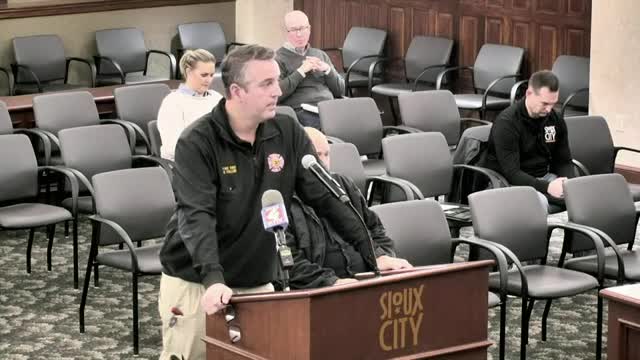Fire Department requests reinstatement of administrative chief amid rising call volume
February 08, 2025 | Sioux City, Woodbury County, Iowa
This article was created by AI summarizing key points discussed. AI makes mistakes, so for full details and context, please refer to the video of the full meeting. Please report any errors so we can fix them. Report an error »

In the heart of Sioux City, the budget meeting on February 8, 2025, unfolded under the watchful gaze of city officials and community members, all eager to understand the financial future of their city services. A significant focus of the discussion was the sustainability of the ambulance services, which have been a lifeline for many residents.
City officials revealed that the Ground Emergency Medical Transport (GMT) program has been financially supportive, initially projected to cost between $750,000 and $1 million annually. However, recent changes in state calculations have begun to erode this financial cushion, raising concerns about future funding. The looming cuts to Medicaid, as hinted by officials, could create a substantial budget gap, threatening the viability of these essential services. “When the feds do what they’re gonna do, that’s a bigger hole than what you’re talking about for all the other things,” one official warned, emphasizing the potential impact on the community.
Amidst these financial concerns, the meeting also addressed the pressing need for an administrative assistant chief position within the fire department, a role eliminated in 2016. The absence of this position has led to an unsustainable workload for current staff, especially as call volumes have surged by 44% since then. The fire department's operations assistant chiefs and fire marshal are now overwhelmed with administrative tasks that detract from their core responsibilities.
The proposed reinstatement of the administrative assistant chief, with an estimated cost of $202,000, aims to alleviate this burden. Officials argued that this role is crucial not only for emergency planning but also for managing policy revisions and budgetary work. “We’re going to reach a breaking point,” one official cautioned, highlighting the urgency of the situation.
As the meeting progressed, the tension between maintaining essential services and managing budget constraints became palpable. City officials grappled with the reality that every decision made today could have lasting consequences for the community. The discussions underscored a critical moment for Sioux City, where the balance between fiscal responsibility and public safety hangs in the balance.
With the future of the ambulance services and the fire department's administrative structure at stake, the city faces a pivotal challenge: how to navigate these financial waters while ensuring that the needs of its citizens are met. As the meeting concluded, the echoes of these discussions lingered, leaving attendees to ponder the implications for Sioux City’s future.
City officials revealed that the Ground Emergency Medical Transport (GMT) program has been financially supportive, initially projected to cost between $750,000 and $1 million annually. However, recent changes in state calculations have begun to erode this financial cushion, raising concerns about future funding. The looming cuts to Medicaid, as hinted by officials, could create a substantial budget gap, threatening the viability of these essential services. “When the feds do what they’re gonna do, that’s a bigger hole than what you’re talking about for all the other things,” one official warned, emphasizing the potential impact on the community.
Amidst these financial concerns, the meeting also addressed the pressing need for an administrative assistant chief position within the fire department, a role eliminated in 2016. The absence of this position has led to an unsustainable workload for current staff, especially as call volumes have surged by 44% since then. The fire department's operations assistant chiefs and fire marshal are now overwhelmed with administrative tasks that detract from their core responsibilities.
The proposed reinstatement of the administrative assistant chief, with an estimated cost of $202,000, aims to alleviate this burden. Officials argued that this role is crucial not only for emergency planning but also for managing policy revisions and budgetary work. “We’re going to reach a breaking point,” one official cautioned, highlighting the urgency of the situation.
As the meeting progressed, the tension between maintaining essential services and managing budget constraints became palpable. City officials grappled with the reality that every decision made today could have lasting consequences for the community. The discussions underscored a critical moment for Sioux City, where the balance between fiscal responsibility and public safety hangs in the balance.
With the future of the ambulance services and the fire department's administrative structure at stake, the city faces a pivotal challenge: how to navigate these financial waters while ensuring that the needs of its citizens are met. As the meeting concluded, the echoes of these discussions lingered, leaving attendees to ponder the implications for Sioux City’s future.
View full meeting
This article is based on a recent meeting—watch the full video and explore the complete transcript for deeper insights into the discussion.
View full meeting
